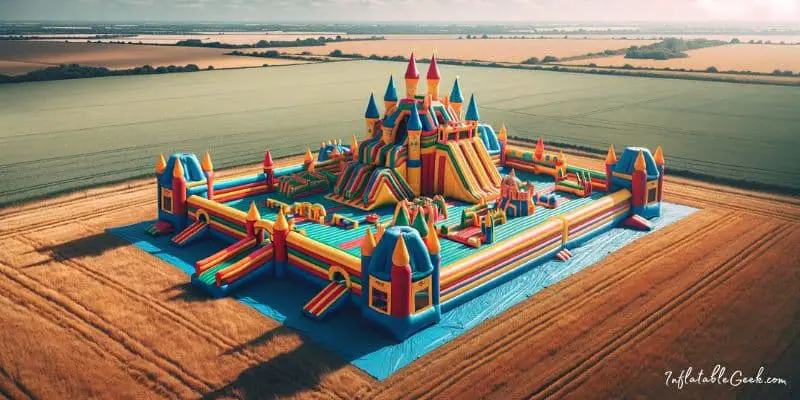Bounce houses are a staple of childhood fun, offering an exhilarating experience for kids and adults alike.
But when it comes to the world’s biggest bounce houses, the excitement reaches new heights. These gigantic inflatables are more than just a play area; they’re a blend of adventure, creativity, and sheer joy.
What Are World’s Biggest Bounce Houses?
(This post may have affiliate links. Please see my disclosure)

Bounce houses, also known as inflatable castles or jumpers, are large, air-filled structures typically used for recreational purposes, especially for children.
The world’s biggest bounce houses, however, are a league apart.
They are massive structures, often covering thousands of square feet, designed to accommodate a large number of people simultaneously.
These aren’t just for jumping.
They’re complete amusement parks made of air, featuring slides, obstacle courses, and interactive games.
As someone who has experienced these giants firsthand, I can attest to the sheer awe and excitement they inspire.
It’s like stepping into a colorful, bouncy world where the only limit is your imagination.
How Do They Work?
The basic principle behind a bounce house is simple – it’s an inflatable structure that is kept inflated by a continuous airflow from a blower.
The air fills up the walls and the floor of the bounce house, making it firm yet bouncy.
The world’s biggest bounce houses take this concept to the extreme.
They require multiple high-powered blowers to keep them inflated due to their massive size.
These structures are typically made of strong, lightweight fabrics like PVC or nylon, which are both durable and flexible.
The seams are reinforced to ensure that they can withstand constant pressure and usage.
Safety is a key concern, so these bounce houses are designed to be as secure as possible, with netting and padded walls to prevent falls.
10 Different Types of World’s Biggest Bounce Houses
Here is a list of some of the most common types of super large bounce houses:
- Classic Castle Bounce Houses – These are the traditional, castle-shaped bounce houses, but on a much larger scale.
- Obstacle Course Bounce Houses – Filled with hurdles, slides, and climbing areas, they provide a thrilling challenge.
- Slide Bounce Houses – These feature giant inflatable slides, some as tall as a two-story building.
- Interactive Game Bounce Houses – Equipped with games and activities, these encourage playful competition.
- Themed Bounce Houses – From pirate ships to space stations, these offer immersive experiences.
- Sports Arena Bounce Houses – Designed for sports enthusiasts, complete with basketball hoops and soccer goals.
- Water Slide Bounce Houses – These combine the fun of a bounce house with water slides, perfect for summer.
- Adventure Park Bounce Houses – A mix of everything, from slides to obstacle courses, offering a complete adventure.
- Educational Bounce Houses – Designed to be fun and informative, often featuring puzzles and learning activities.
- Combo Bounce Houses – These offer a combination of jumping areas, slides, and interactive games.
Here is an example of one of the biggest bouncy houses in the entire world:
Pros and Cons of World’s Biggest Bounce Houses
Here are the pros and cons of the world’s biggest bouncy houses:
Pros
- Immense Fun and Excitement: They offer unparalleled joy and entertainment for all ages.
- Physical Activity: Encourages exercise and physical play, which is beneficial for health.
- Social Interaction: A great way for children and adults to interact and make new friends.
Cons
- Cost: They can be quite expensive to rent or purchase.
- Space Requirements: Need a large open area for setup.
- Safety Concerns: While generally safe, there’s always a risk of injury, especially if safety guidelines are not followed.
How to Set Up the World’s Biggest Bouncy Houses
Setting up one of the world’s biggest bounce houses is a task that requires careful planning and execution.
Unlike smaller bounce houses, these giant structures often need a team and specialized equipment.
Here’s how it’s typically done:
- Choose the Right Location: First, select a flat, open area free from overhead obstructions like power lines or trees. The surface should be grassy or padded to ensure safety.
- Unroll and Position: The bounce house is transported in a deflated state. Once on site, it’s unrolled and laid out in the chosen location. This process can be labor-intensive due to the size and weight of the material.
- Attach Blowers: Multiple high-capacity blowers are connected to the inflation tubes of the bounce house. These blowers must be powerful enough to fill the large space and keep it inflated.
- Inflate: Once everything is connected, the blowers are turned on. The inflation process can take a significant amount of time, depending on the size of the bounce house.
- Secure and Anchor: As the bounce house inflates, it’s crucial to secure it to the ground using heavy-duty stakes or weights. This prevents it from shifting or tipping over.
- Safety Checks: Before allowing anyone to enter, conduct thorough safety checks. Ensure that all sections are fully inflated and that there are no leaks or weak spots.
From my personal experience, watching one of these giants come to life is almost as exciting as playing in it.
The transformation from a flat piece of fabric to a towering, vibrant structure is nothing short of magical.
How to Deflate and Take Down the World’s Biggest Bouncy Houses
Deflating and taking down a massive bounce house is as crucial as setting it up.
It involves several steps to ensure it’s done safely and efficiently:
- Clear the Area: Ensure that everyone is out of the bounce house and that the area is clear of any objects that could damage the fabric.
- Turn Off and Disconnect Blowers: Shut off all the blowers and disconnect them from the inflation tubes.
- Deflation: The bounce house will begin to deflate on its own once the blowers are off. This process can be slow and needs monitoring to ensure it deflates evenly.
- Folding and Rolling: Once deflated, the fabric needs to be carefully folded and rolled. This is a critical step to avoid damaging the material and to ensure it fits back into its storage space.
- Transport and Storage Preparation: The rolled-up bounce house must be protected from sharp objects and moisture during transport and storage.
Having been involved in this process, I can say it requires patience and care. The key is to ensure that the material is not strained or torn during deflation and folding.
Storage and Maintenance Tips
Proper storage and maintenance are essential for keeping these large bounce houses in good condition:
- Cleaning: Regularly clean the bounce house, especially after each use. Use mild soap and water, and avoid harsh chemicals.
- Dry Completely: Before storing, make sure the bounce house is completely dry to prevent mold and mildew.
- Check for Damages: Regularly inspect for any tears, holes, or seam damages. Prompt repairs are necessary to avoid further damage.
- Proper Storage: Store in a cool, dry place. Avoid areas where it might be exposed to sharp objects or extreme temperatures.
- Regular Air Blower Maintenance: Keep the air blowers clean and in good working condition, as they are crucial for the operation of the bounce house.
FAQs: Exploring the World of Giant Bouncy Houses
Here are answers to some of the most frequently asked questions about giant bounce houses.
How Long Does a Giant Bounce House Last?
The lifespan of a giant bounce house largely depends on its usage and maintenance.
Typically, with proper care and regular maintenance, these massive inflatables can last anywhere from 3 to 5 years, and sometimes even longer.
Factors such as the frequency of use, the quality of the material, exposure to harsh weather conditions, and how well it’s cleaned and stored all play a role in its longevity.
Regular inspections for wear and tear, along with timely repairs, can significantly extend its life.
Can Adults Safely Use the World’s Biggest Bounce Houses?
Absolutely! The world’s biggest bounce houses are designed to accommodate not just children but adults as well.
They are built with stronger materials and have higher weight capacities to ensure they can handle the additional weight and stress caused by adults.
However, it’s crucial for adults to follow all safety guidelines, such as avoiding overcrowding and not performing risky stunts.
These precautions ensure everyone’s safety and enjoyment.
Are There Weight Limits for These Bounce Houses?
Yes, even the largest bounce houses have weight limits.
These limits are determined based on the size and design of the bounce house and the strength of the materials used.
It’s essential to adhere to these limits to ensure the safety of users and the integrity of the structure.
Overloading a bounce house can lead to increased wear and tear or even cause it to fail, posing a safety hazard.
How Many People Can a Giant Bounce House Accommodate?
The capacity of a giant bounce house varies based on its size and design.
Some of the largest models can accommodate hundreds of people at a time. However, it’s important to follow the manufacturer’s recommendations for maximum occupancy to ensure safety.
Overcrowding can lead to accidents and reduce the enjoyment of the experience.
Organizers should manage the number of people entering and ensure that there’s enough space for everyone to play safely.
What Happens If a Bounce House Gets a Puncture?
If a bounce house gets a puncture, it will start to slowly deflate.
Most giant bounce houses are designed with multiple air chambers, so a puncture in one area won’t cause the entire structure to collapse immediately.
It’s essential to evacuate the bounce house calmly and safely if this happens.
The puncture can usually be repaired with patch kits specifically designed for inflatable structures.
Regular inspections can help identify and fix vulnerabilities before they become a problem.
Can These Bouncy Houses Be Customized?
Yes, many companies offer customization options for these giant bounce houses.
Customers can choose themes, colors, and even specific features like slides, obstacle courses, or branding elements.
Customization allows for a personalized experience, whether for private events, corporate functions, or community gatherings.
However, customization might affect the cost and the time required for manufacturing and delivery.
Is Special Training Required to Operate These Bounce Houses?
Operating a giant bounce house does require some level of training, particularly in terms of safety and emergency procedures.
Those responsible for setting up and supervising the bounce house should understand how to properly anchor and inflate it, monitor its use, and respond to emergencies like punctures or extreme weather conditions.
Many rental companies offer training sessions or provide trained staff as part of their service.
For those purchasing a bounce house for regular use, attending a training course is highly recommended.
Final Thoughts: World’s Biggest Bounce Houses
Leap into the colossal fun world of giant bouncy houses.
For more inflatable goodies, check out the other fun articles on this website.
Related Posts:
